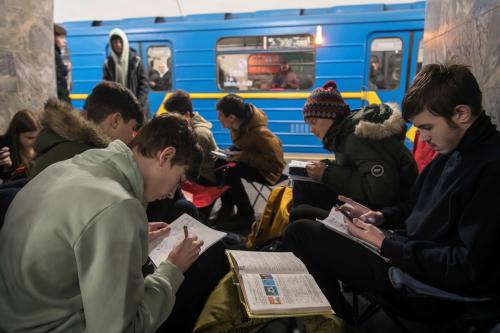This op-ed was originally published by Project Syndicate.
The Islamic Republic of Iran marks its 40th anniversary this week. But, with the country beset by a severe economic crisis, the question on everyone’s lips—within Iran and the diaspora alike—seems to be whether the Islamic Revolution has actually improved Iranians’ lives.
Since last May, when the United States withdrew from the 2015 Joint Comprehensive Plan of Action—better known as the Iran nuclear deal—and re-imposed its toughest sanctions on Iran, the Iranian economy has taken a nosedive. The currency has lost 70 percent of its value, and prices are rising at a 40 percent annual rate, placing new strain on an already underperforming economy, in which one-third of university-educated young people are out of work.
U.S. President Donald Trump’s administration seems to hope that, with a nudge from sanctions, ordinary Iranians will rise up and overthrow the Islamic Republic. In a major speech to the Iranian-American community last July—widely viewed as a call for regime change—U.S. Secretary of State Mike Pompeo declared that the Islamic regime had put “Iran into a long-term economic tailspin,” pushing “a third of Iranians … below the poverty line.”
But a closer look at the data on Iran’s economy does not support the view that the Iranian public has been driven into abject poverty since 1979, let alone that it is on the brink of revolting. True, many older Iranians have fond memories of the decade before the Revolution, when the country experienced robust growth that tripled per capita GDP.
Yet Iran also performed well after the Revolution. In 1995-2011—before Trump’s predecessor, Barack Obama, imposed growth-stifling sanctions—Iran achieved per capita GDP growth (in purchasing power parity terms) of 8.7 percent, on average, compared to just 2.9 percent in neighboring Turkey.
Indicators of individual welfare show similar improvements. Based on the combination of per capita income, educational attainment, and life expectancy, the 2018 Human Development Report ranked Iran 60th out of 189 countries, ahead of Turkey (64), Mexico (74), and Brazil (79).
Moreover, survey data have shown consistent improvements in Iranians’ access to basic services and household amenities. Today, all households in Iran have access to electricity and clean water, up from 43 percent and 33 percent, respectively, in 1973. Cheap natural gas—non-existent before the Revolution—is now piped into 85 percent of all homes.
The comparison is even more favorable when one considers that Iran’s oil wealth—which underpinned living standards in the 1970s—has been shrinking. Thanks to historically high prices in the five years before the Revolution (1974-1979), Iran’s oil revenues amounted to an unprecedented $1.03 trillion (valued in 2018 dollars), or about $5,000 per person per year. The most lucrative five-year period after the Revolution—2007-2011—brought just $0.6 trillion in oil revenues, or $1,365 per person per year (which also reflects the more than twofold increase in population since 1979).
Despite this decline, the Islamic Republic has gone a long way toward fulfilling some of its key promises, such as reducing poverty. In the 1970s, urban households received a far larger share of the oil bounty than disadvantaged rural households. For example, in 1973-1975, the share of urban households with access to piped water rose from 65.4 percent to 79.7 percent, whereas in rural areas it increased from a mere 7.6 percent to 8.5 percent.
Since the Revolution, however, Iran’s leaders have pursued investments in infrastructure that have expanded access not just to piped water, but also to health and education, for rural areas. As a result, poverty has been reduced substantially, from over 20 percent in the early 1970s to less than 10 percent in 2014.
Yet, as with most revolutionary regimes, the Islamic Republic’s successes have stemmed more from direct government policies, such as the delivery of basic services and cash to the poor, than from those that depend on market incentives. This accounts for the lack of sufficient jobs: Unemployment among university-educated youth, which was non-existent in the 1970s, has surged to 30 percent for men and 50 percent for women.
Moreover, while post-Revolution Iran has improved equity in some areas, it has been less effective in reducing income inequality. The Gini coefficient (a common measure of income inequality, with zero representing maximum equality) has remained above 0.40, not much lower than it was in the early 1970s.
Of course, when it comes to quality of life, economic indicators do not tell the whole story. And, while living standards for average Iranians are in many ways measurably better under the Islamic Republic than they were under the Shah, that does not make up for high unemployment, let alone the social restrictions that have been imposed since 1979. Still, the Trump administration’s goal of regime change from within seems a distant one.




Commentary
Op-edThe Islamic Revolution at 40
February 12, 2019